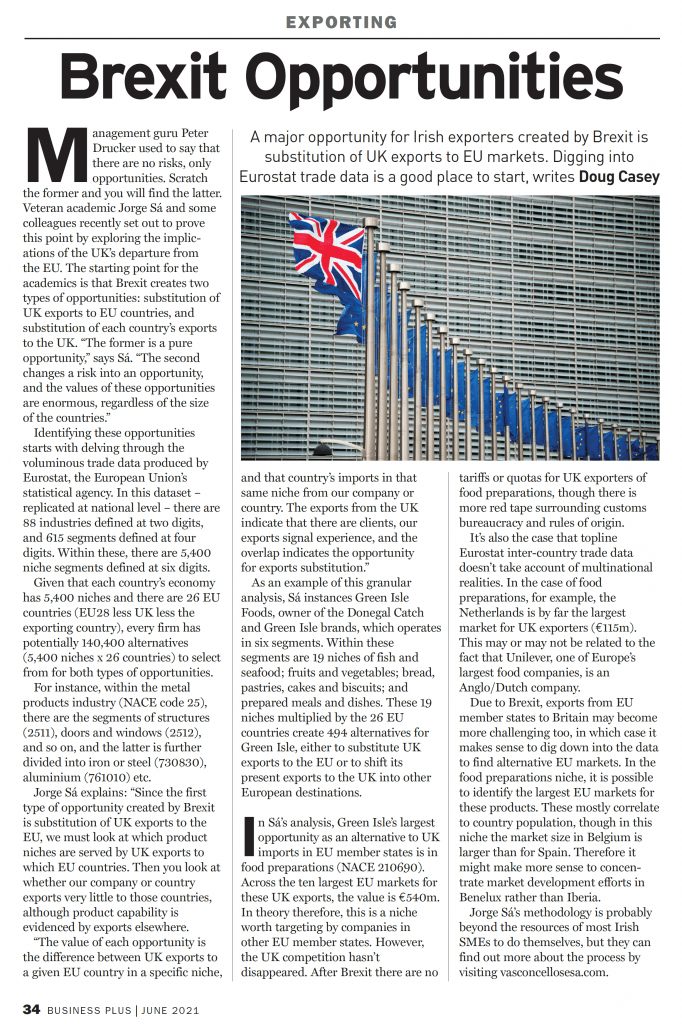
Brexit Opportunities
A major opportunity for Irish exporters created by Brexit is substitution of UK exports to EU markets. Digging into Eurostat trade data is a good place to start, writes Doug Casey.
Management guru Peter Drucker used to say that there are no risks, only opportunities. Scratch the former and you will find the latter. Veteran academic Jorge Sá and some colleagues recently set out to prove this point by exploring the implications of the UK’s departure from the EU. The starting point for the academics is that Brexit creates two types of opportunities: substitution of UK exports to EU countries, and substitution of each country’s exports to the UK. “The former is a pure opportunity,” says Sá. “The second changes a risk into an opportunity, and the values of these opportunities are enormous, regardless of the size of the countries.”
Identifying these opportunities starts with delving through the voluminous trade data produced by Eurostat, the European Union’s statistical agency. In this dataset – replicated at national level – there are 88 industries defined at two digits, and 615 segments defined at four digits. Within these, there are 5,400 niche segments defined at six digits.
Given that each country’s economy has 5,400 niches and there are 26 EU countries (EU28 less UK less the exporting country), every firm has potentially 140,400 alternatives (5,400 niches x 26 countries) to select from for both types of opportunities.
For instance, within the metal products industry (NACE code 25), there are the segments of structures (2511), doors and windows (2512), and so on, and the latter is further divided into iron or steel (730830), aluminium (761010) etc.
Jorge Sá explains: “Since the first type of opportunity created by Brexit is substitution of UK exports to the EU, we must look at which product niches are served by UK exports to which EU countries. Then you look at whether our company or country exports very little to those countries, although product capability is evidenced by exports elsewhere.
“The value of each opportunity is the difference between UK exports to a given EU country in a specific niche, and that country’s imports in that same niche from our company or country. The exports from the UK indicate that there are clients, our exports signal experience, and the overlap indicates the opportunity for exports substitution.”
As an example of this granular analysis, Sá instances Green Isle Foods, owner of the Donegal Catch and Green Isle brands, which operates in six segments. Within these segments are 19 niches of fish and seafood; fruits and vegetables; bread, pastries, cakes and biscuits; and prepared meals and dishes. These 19 niches multiplied by the 26 EU countries create 494 alternatives for Green Isle, either to substitute UK exports to the EU or to shift its present exports to the UK into other European destinations.
In Sá’s analysis, Green Isle’s largest opportunity as an alternative to UK imports in EU member states is in food preparations (NACE 210690).
Across the ten largest EU markets for these UK exports, the value is €540m. In theory therefore, this is a niche worth targeting by companies in other EU member states. However, the UK competition hasn’t disappeared. After Brexit there are no tariffs or quotas for UK exporters of food preparations, though there is more red tape surrounding customs bureaucracy and rules of origin.
It’s also the case that topline Eurostat inter-country trade data doesn’t take account of multinational realities. In the case of food preparations, for example, the Netherlands is by far the largest market for UK exporters (€115m). This may or may not be related to the fact that Unilever, one of Europe’s largest food companies, is an Anglo/Dutch company.
Due to Brexit, exports from EU member states to Britain may become more challenging too, in which case it makes sense to dig down into the data to find alternative EU markets. In the food preparations niche, it is possible to identify the largest EU markets for these products. These mostly correlate to country population, though in this niche the market size in Belgium is larger than for Spain. Therefore it might make more sense to concentrate market development efforts in Benelux rather than Iberia. Jorge Sá’s methodology is probably beyond the resources of most Irish SMEs to do themselves, but they can find out more about the process by visiting vasconcellosesa.com.
